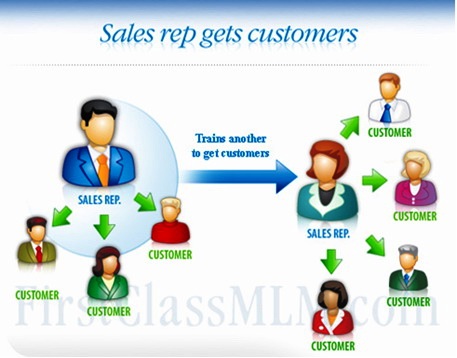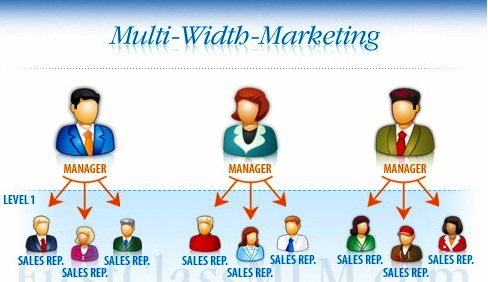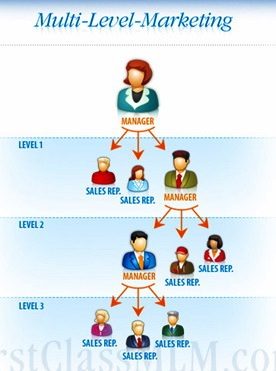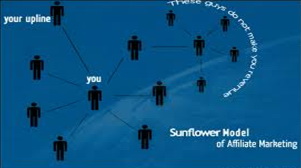MORE FREE TERM PAPERS MARKETING:
|
||||||||
MUTI-LEVEL MARKETING
Multilevel marketing plans are ways to sell goods
or services through distributors. Typically, these plans promise
that if a person sign up as a distributor, he will get commissions not
only from the sales he make, but also from the sales of the people he
recruit to become distributors. Multilevel or network marketing is one
of the only businesses available that allows a person with potentially
no resources to start their own business with absolutely no limit on their
financial success. Mostly this technique is used by the Marketing and
manufacturing industries to popularize their products among the customers.
It is an effective and powerful tool for improving the sales and leads
of an organization.
Multi-level marketing (MLM), also known as “network marketing”
is a business distribution model that allows a parent multi-level marketing
company to market their products directly to consumers by means of relationship
referral and direct selling. Independent unsalaried salespeople of multi-level
marketing referred to as “distributors” (associates, independent business
owners, franchise owners, sales consultants, consultants, independent
agents, etc.) represent the parent company and are rewarded a commission
relative to the volume of product sold through each of their independent
businesses (organizations). Independent distributors develop their organization
by either building an active customer base, who buy direct from the parent
company and/or by recruiting a downline of independent distributors who
also build a customer base, expanding the overall organization. Additionally,
distributors can also earn a profit by retailing products which they purchased
from the parent company at wholesale price. Distributors earn a commission
based on the sales efforts of their organization, which includes their
independent sale efforts as well as the leveraged sales efforts of their
downline. This arrangement is similar to franchise arrangements where
royalties are paid from the sales of individual franchise operations to
the franchisor as well as to an area or region manager. Commissions are
paid to multi-level marketing distributors according to the company’s
compensation plan. There can be multiple levels of people receiving royalties
from one person's sales.
It is common knowledge that MLM works on the concept of time leverage.
A work to be done by a person in 100 days can be completed in one day
if he have 100 people under him (in a chain) doing one day's work. He
earns a % of incentive for the work done by each of these 100 people.
Though it is given various names like Network marketing, freelance marketing,
chain marketing, the basic principle is that a happy consumer brings in
more customers for which he is getting an incentive. The net work plan
or income schemes vary from company to company. The more reputed companies
in MLM in India and abroad are, Amway, Modicare, Oriflamme, Tupperware,
Quantum, RMP, Goodways, Placement Services etc. All these companies have
web based information system where a member can monitor the growth of
his down line memberships, incomes accrued etc.
Multi Level Marketing is based on the principle of not only passing commissions
of the first line a person sell, but also a part of the commission he
makes, and a smaller part again of what these sell and so on up to a pre-defined
level. In this way automatically the total of commissions for him grows
exponentially. Because of the automization of the system this works completely
on autopilot and for every sale he will have a potential font of more
commissions.

Example of the MLM system
Multiple levels of people are marketing a product to consumers. A sales
representative (also referred to as a distributor, member, affiliate,
partner or associate) gets customers and recruits and trains another
sales representative to get customers. Multiple levels of marketing
are actually what all companies' desire. Health clubs, real estate,
telecommunications, and countless other industries use this technique.
Professionals (doctors, dentists, accountants) live or die based on
their customers telling others about them. All these businesses are
simply trying to get current customers to advertise and market their
product or service to potential customers.

Sales representative gets customers and trains another sales representative to get customers
Multi-Width Marketing
In a non-MLM company, a sales manager and sales reps are hired by the
company. The company is limited to the number of sales representatives
they can hire based on the financial resources the company has to pay
salaries and on the traffic the sales manager can handle. Once a sales
manager is overwhelmed, the company can hire another manager or convert
a sales rep into a manager. This could be called “Multi-Width” marketing
because it expands the organization horizontally as compared to “Multi-Level”
marketing, which expands its organization vertically.

Traditional companies (non-MLM) use “Multi-Width” Marketing
The MLM (Multi Level Marketing) Company
An MLM (Multi Level Marketing) company “starts” by recruiting one person
who gets customers and recruits sales representatives (just as above in
the traditional company). But each sales representative is also given
the option to become a manager, who can also recruit sales reps. The MLM
company only pays commissions, not salaries; therefore, there are no limitations
on the number of sales representatives or managers an MLM company can
recruit. This is beneficial to the company because of rapid expansion
by the number of trained sales representatives. This is also beneficial
to the sales representatives because their income isn’t limited to only
what they can sell - they can also earn commissions for having trained
other sales representatives.

MLM uses “Multi-Level” Marketing, which is similar to traditional marketing
(“Multi-Width-Marketing,”) except there is no limit to growth.
Very simply and factually, MLM (Multi Level Marketing) is one of the
five main methods used by a company to sell and distribute a product or
a service to a consumer. All companies (MLM or traditional companies)
have one main characteristic in common: they provide a product or a service
that hopefully makes a consumer’s life better. Once a company has such
a product or service they need to make it widely known. They do this by
distributing it. Distributing a product involves finding customers and
getting the product in their hands.
There are five primary ways to distribute a product or service:
1. Store front - Company rents or buys a store in busy
area to get walk-in traffic. Hires sales person to communicate with customers
who walk in.
2. Direct mail - Company buys addresses. Hires marketing
person to write and send written communication about products and or services
through the mail.
3. Tele marketing - Company buys telephone numbers of
prospects. Hires and trains sales people to call and sell products/services
via the phone.
4. Internet - Company puts up a web site and advertises
to get traffic. Similar to direct mail, the marketing occurs through written
communication.
5. MLM - Company recruits a distributor (sales representative)
to sell products. Grants sales person right to recruit other sales reps
to sell products.
Each of the five methods above can use techniques from one or more of
the other methods to get customers. Meaning, a Store Front isn’t limited
to only walk-in traffic. The Store Front can also advertise on radio,
television and in newspapers, magazines, and mailers (post cards, flyers,
etc.) directing prospects to the store location. This can increase the
number of people walking into their store. Similarly, a distributor in
an MLM company can use some or all of the 4 other methods as well as getting
customers through friends and family. The main point to understand is
that distributing any product means to make it known. MLM and the other
four primary ways to distribute a product are simply methods used to make
a product known.
MLM is Organic
Organically, the MLM industry is a fantastic model. Organic means it is
the purest way to move a product to a consumer and the purest way to be
compensated. It is organic because:
1. In its organic state one person shares a valuable product or service
with another (not because they will profit, but because the product is
valuable). “I like it, maybe you will too.” That is clean and pure.
2. A person shares a business idea with another - this is the foundation
of all businesses throughout history. “I found a business I like and maybe
you’d like to work on it with me.” That too is clean and pure.
3. The person who shares the business with another ONLY profits IF the
person they shared the business with succeeds - that is ultra-responsible,
which is also clean and pure.
MLM Vs PYRAMID SELLING
The big difference between MLM and a pyramid scheme is in the business'
operations. The entire purpose of a pyramid scheme is to get your money
and then use you to recruit other suckers. The entire purpose of MLM is
to move product. The theory behind MLM is that the larger the network
of distributors, the more product the business will be able to sell.
1. Position in the scheme is important
The pyramid scheme consists of few people at the top and an increasing
number of members in each layer below. Money paid in by new investors'
flows from the bottom to the top. It is therefore important to be at,
or close to, the top of the pyramid. By design around 90% of members will
make a loss and only 1% will make a significant profit. It is the position
within the scheme which dictates whether or not you'll make money; not
how hard you work at it.
MLM was born out of pyramid schemes and as such the structure and the
nature is very similar. The concept of the downline that will earn money
works in the same way; you sponsor new members and earn commission from
them in a multilevel structure. As with an illegal pyramid scheme, unless
you are at or near the top of the pyramid it is likely that you will lose
money. Once the scheme has passed its saturation point, no amount of hard
work or enthusiasm will make a difference.
2. Earn money by recruiting
The idea of a pyramid scheme is to encourage other people to join it below
you in a potentially endless chain. You then take a percentage of their
joining fee and you also get a percentage of the joining fee of any new
members signed up by your new recruit, and so on, up to several layers
deep. This is where the promise of great wealth comes in and is how the
scam is sold.
In reality this cannot be achieved. Due the difficulty of attracting new
recruits, 90% of members are always at, or near, the bottom of the pyramid
and will lose their money. It is this built-in feature of pyramids, which
guarantees failure for the vast majority that renders them illegal.
The difference between a pyramid scheme and an MLM is that MLM schemes
are in the business of selling goods to consumers. This is what makes
them legal. Most MLM schemes in reality, however, promote themselves with
the promise of great wealth: the appeal to greed. Selling products to
consumers is not the way to make riches in MLM. Any MLM scheme will make
it absolutely clear that the only way to make real money is through the
recruitment of new members and the creation of a downline.
3. Profits come from others' investments
The promise of great wealth comes from the concept of a "downline".
This downline consists of the members that you yourself introduce to the
scheme, and subsequently the new recruits that your members also introduce.
You will receive a percentage of the investment that each member introduces
to the scheme. With a downline several layers deep the potential is there
for a downline consisting of many thousands of people.
In reality this downline is unachievable both practically and mathematically.
This is the inherent fraud in pyramid schemes. They are bound to fail
by design.
The downline is the key component to making money in MLM. The concept
is identical to illegal pyramid schemes - one make money from the people
you introduce into the scheme. The pitfalls are exactly the same as with
pyramids; the vast majority is bound to lose money by design.
Pyramids are illegal. MLM schemes are legal because of the fact that products
are sold. This is the only real difference between the two systems. If
you remove the products from an MLM, all that is left is a pyramid scheme,
this is why MLMs are known as product based pyramid schemes.
Sunflower Model Vs Binary Model of MLM
Sunflower model of MLM:

Pretty much all of the affiliate programs on the web follow the sunflower model. This means if you refer a 100 people to join a website, or make 100 sales, they would all be counted as direct sales and a decent % of each sale would be given to you. However, your commissions are in direct proportion to the direct referrals you bring in (only based on your direct referrals). Say that you referred a friend, who happens to be great at marketing. He too makes 100 sales. This would, in no way affect you. You would have no advantage of his network.
Binary model of MLM:

Every person under you would generate revenue for you. It is immaterial if the person under your position in the chain was brought by you into the network or someone above you brought him into the network. The commission per sale would be lesser than that of Sunflower model, but in the long run, binary model would result in a larger and continuous stream of revenue as someone below you would still continue sales even when you stopped working and you’d keep earning through leverage.
Internet Multi level marketing
As the name implies, internet network marketing is when you “bring your
business online” and for most that starts with lead generation. Internet
multi level marketing really comes down to two things - traffic generation
and the ability to write or use video persuasively to get people to do
what you want them to do.
Now, in terms of traffic generation for the business, it needs to the
right kind of traffic, not just any, but targeted traffic is the best
kind to get. You need to first pinpoint exactly who wants and needs your
product, what kinds of people your product or opportunity solves problems
for and market directly to them to generate the best kinds of leads.
Now you can go about lead generation for your internet multi level marketing
business in any number of ways - pay per click marketing, search engine
optimization, article or video marketing, social media marketing, how
you do it is up to you.
Next comes converting those leads into profit in the form either product
customers or business partners. Really what that all comes down to in
internet network marketing is more commonly known in the business world
as the ability to convey meaning using copywriting or persuasive language
or videos.
Now, one thing that can be done to increase the odds in the favor is that
you can communicate with those leads via email and gradually drip good
content to them over time, winning them over.
Success behind Amway
MLM that is Multi-level Marketing is a particularly structured marketing
strategy. One of the biggest MLM Companies is Amway.
The Amway business model is based on their Business Owner Compensation
Plan, low risk and low cost business prospect which are open to all. Amway’s
Compensation Plan is one of the oldest plans ever created in MLM.
Following are the steps taken by Amway that led to the success:
Step 1: Product Knowledge - A good knowledge of the products
is essential as that will help to make them more marketable to the customer.
Usage of the product by the distributor is the simplest way to acquire
knowledge about the different aspects of the product.
Step 2: Retail Sell - It is about selling the products
to end customers, i.e. people around the distributor, someone he or she
knows as an acquaintance. Good product knowledge helps in discovering
the need for certain products among people whom we know. For example a
distributor while chatting with his friend finds out that the friend is
looking for a bathing soap that is low in alkaline content. The distributor
from his acquired knowledge of the products knows that they have a soap
which is low in alkaline content and is good for skin. So the distributor
proposes his friend to try out that soap. This is one way distributors
can acquire new customers, essentially from the people around them. Each
sell in turn earns a profit margin to the distributor as he or she has
bought the products in a wholesale price from the Amway.
Step 3: Sponsoring new distributor: The distributor can
also make profits by introducing new distributors to the MLM business
chain. In MLM world this is known as Sponsoring. When a distributor sponsors
another new distributor, he or she gets a commission from the sell volume
that their sponsored distributor generates. This means more your sponsor
more is the commission profit from indirect sells by your sponsors.
Failure of multi-level marketing
There are always bad apples in the bushel and this industry was no exception.
Multi level Marketing is not a very viable concept, even theoretically,
nor is it a very profitable means of distribution for all parties involved
in Multi level Marketing. This non-viability is basically caused by a
heightened expectation of easy money. In fact the concept of Multi level
Marketing is no longer new. It is also exempt from the normal rules of
the market and the way goods and services are otherwise sold. Many companies
have tried the concept of Multi level Marketing and most of them have
failed. Some of the Multi level marketing efforts have in fact been miserable
failures in spite of the fact that they offer excellent products. After
almost 25 years of failed attempts in the area of Multi level marketing,
it is time to analyze the reasons for its failures.
Firstly it is important to analyze the driving mechanism of Multi level
Marketing. The driving mechanisms are intrinsically unstable, and therefore
tend to over saturate the market with no one noticing. Multi level Marketing
can never equalize into profitability the way companies in the real world
can. This is the reason that the organization as a whole cannot, be profitable.
It is usually the unfortunate distributor at the bottom who is the loser.
Of course money can be made with Multi level Marketing. But the money
being made is not always legitimate.
The 4 Major Factors that Hinder 95% of Network Marketers from Achieving
True Success are:
1. Lack of marketing budget/knowledge of target marketing
2. Lack of true effective action or any action at all
3. Lack of consistent flow of quality prospects
4. Lack of training and underdeveloped skills
The three strategies of selecting number of intermediaries
Companies must decide on the number of intermediaries to use at each channel
level. The three strategies are:
1. Exclusive distribution – This means severely limiting
the number of intermediaries. It's appropriate when the producer wants
to maintain control over the service level and outputs offered by the
resellers.
2. Selective distribution – This relies on more than
a few but less than all of the intermediaries willing to carry a particular
product. It makes sense for established companies and for new companies
seeking distributors. The company does not need to worry about too many
outlets, it can gain adequate market coverage with more control and less
cost than intensive distribution.
3. Intensive distribution - In this type of distribution
the manufacturer places the goods or services in as many outlets as possible.
This strategy is generally used for items such as snack foods, soft drinks,
news papers, products the consumer seeks to buy frequently or in a variety
of locations. This strategy may help in the short term, but can hurt long-term
performance. Intensive distribution increases product and service availability
but may also encourage retailers to compete aggressively. Price wars may
erode profitability, potentially dampening retailer interest in supporting
the product and harming brand equity.
Designing the sales force
The original and oldest form of direct marketing is the field of sales
call. Today most industrial companies rely on a professional sales force
to locate prospects, develop them into customers and grow the business,
or they hire manufacturers' representatives and agents to carry out the
direct-selling task. Companies are trying to increase the productivity
of the sales force through better selection, training, supervision, motivation
and compensation. Sales representative covers six positions, ranging from
the least to the most creative types of selling:
1. Deliverer – A salesperson whose major task is the
delivery of a product
2. Order taker – An inside order taker stands behind
the counter and outsider order taker calls the manager.
3. Missionary – A salesperson not expected or permitted
to take an order but rather build goodwill or educate the actual or potential
user.
Example: A medical detailer representing an ethical pharmaceutical house.
4. Technician – A salesperson with a high level of technical
knowledge.
Example: The engineering salesperson who is primarily a consultant to
client companies.
5. Demand Creator – A salesperson who relies on creative
methods for selling tangible products or intangibles.
6. Solution Vendor – A salesperson whose expertise is
solving a customer's problem, often with a system of the company's products
and services.

